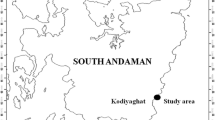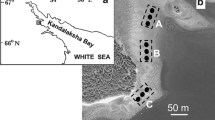Abstract
Given the quiescent physical environment and the low rates of bioturbation in the deep sea, biologically produced structures, such as animals tubes, may play an important role in creating habitat heterogeneity. In San Diego Trough, the cirratulid polychaete Tharyx luticastellus builds and inhabits a robust mud concretion (a mudball). Mudballs are abundant and persist after the worm has died or abandoned them. Our analysis of twelve 6.6-cm-diameter cores from 32° 51.02′ N, 117° 46.97′ W, taken with the submersible SEA CLIFF, indicate that one of 29 species of harpacticoids common in San Diego Trough is associated with Tharyx mudballs. This species (of the genus Heteropsyllus) responded only to mudballs containing worms, suggesting that any effects of the inanimate structure were not the cause of the association. We could detect no difference in bacterial numbers in sediments between control and occupied-mudball samples. This result suggests that the response does not result from gross differences in food levels near a mudball, but the possibility that there are differences in some preferred food cannot be discounted. An univestigated possibility is that Heteropsyllus responds to occupied mudballs because the worm's presence deters some (presumably small) predator.
Similar content being viewed by others
References
Aller, J. Y. & R. C. Aller, 1986. Evidence for localized enhancement of biological activity associated with tube and burrow structures in deep-sea sediments at the HEBBLE site, western North Atlantic. Deep-Sea Res. 33: 755–790.
Barham, E. G., N. J. Ayer Jr. & R. E. Boyce, 1967. Macrobenthos of the San Diego Trough: photographic census and observations from the bathyscaph, Trieste. Deep-Sea Res. 14: 773–784.
Balkwill, D. L., D. P. Labeda & L. E. Casida, Jr., 1975. Simplified procedures for releasing and concentrating microorganisms from soil for transmission election microscopy viewing as thin-sectioned and frozen-etched preparations. Can. J. Microbiol. 21: 252–262.
Barnett, P. R. O., 1968. Distribution and ecology of harpacticoid copepods of an intertidal mud flat. Int. Revue ges. Hydrobiol. Hydrogr. 53: 177–209.
Bell, S. S. & L. D. Coen, 1982. Investigations of epibenthic meiofauna. I. Abundances on and repopulation of the tube caps of Diopatra cuprea (Polychaeta: Onuphidae) in a subtropical system. Mar. Biol. 67: 303–309.
Bell, S. S. & K. Walters & J. C. Kern, 1984. Meiofauna from seagrass habitats: a review and prospectus for future research. Estuaries 7: 331–338.
Bernstein, B. B., R. R. Hessler, R. Smith & P. A. Jumars, 1978. Spatial dispersion of benthic Foraminifera in the abyssal central North Pacific. Limnol. Oceanogr. 23: 401–416.
Brown, B. W., Jr. & M. Hollander, 1977. Statistics: a biomedical introduction. Wiley, New York, 456 pp.
Carman, K. R. & D. Thistle, 1985. Microbial food partitioning by three species of benthic copepods. Mar. Biol. 88: 143–148.
Coull, B. C., 1972. Species diversity and faunal affinities of meiobenthic Copepoda in the deep sea. Mar. Biol. 14: 48–51.
Eckman, J. E., 1985. Flow disruption by an animal-tube mimic affects sediment bacterial colonization. J. mar. Res. 43: 419–435.
Eckman, J. E. & A. R. M. Nowell, 1984. Boundary skin friction and sediment transport about an animal-tube mimic. Sedimentology 31: 851–862.
Emery, K. O., 1960. The sea off southern California: a modern habitat for petroleum. Wiley & Sons, New York, 366 pp.
Gooday, A., 1984. Records of deep-sea rhizopod tests inhabited by metazoans in the North-east Atlantic. Sarsia 69: 45–53.
Hicks, G. R. F., 1977. Species associations and seasonal population densities of marine phytal harpacticoid copepods from Cook Strait. N. Z. J. mar. freshwater Res. 11: 621–643.
Hobbie, J. E., R. J. Daley & S. Jasper, 1977. Use of Nuclepore filters for counting bacteria by fluorescence microscopy. Appl. envir. Microbiol. 33: 1225–1228.
Jumars, P. A., 1974. Dispersion patterns and species diversity of macrobenthos in two bathyal communities. Ph. D. dissertation, Univ. Calif., San Diego. 204 pp.
Jumars, P. A., 1975a. Environmental grain and polychaete species' diversity in a bathyal benthic community. Mar. Biol. 30: 253–266.
Jumars, P. A., 1975b. Target species for deep-sea studies in ecology, genetics, and physiology. Zool. J. inn. Soc. 57: 341–348.
Jumars, P. A., 1976. Deep-sea species diversity: does it have a characteristic scale? J. mar. Res. 34: 217–246.
Jumars, P. A. & A. R. M. Nowell, 1984. Fluid and sediment effects on marine benthic community structure. Am. Zool. 24: 45–55.
Kern, J. C. & G. L. Taghon, 1986. Can passive recruitment explain harpacticoid copepod distributions in relation to epibenthic structure? J. exp. mar. Biol. Ecol. 101: 1–24.
Kitchell, J. A., J. F. Kitchell, D. L. Clark & L. Dangeard, 1978. Deep-sea foraging behavior: its bathymetric potential in the fossil record. Science, New York 200: 1289–1291.
Montagna, P. A., 1982. Sampling design and enumeration statistics for bacteria extracted from marine sediments. Appl. envir. Microbiol. 43: 1366–1372.
Montagna, P. A., 1984. In situ measurement of meiobenthic grazing rates on sediment bacteria and edaphic diatoms. Mar. Ecol. Prog. Ser. 18: 119–130.
Noodt, W., 1971. Ecology of the Copepoda. Smithson. Contr. Zool. 76: 97–102.
Rieper, M., 1982. Feeding preferences of marine harpacticoid copepods for various species of bacteria. Mar. Ecol. Prog. Ser. 7: 303–307.
Rex, M. A., 1981. Community structure in the deep-sea benthos. Annu. Rev. Ecol. Syst. 12: 331–353.
Rotenberry, J. T. & J. A. Wiens, 1985. Statistical power analysis and community-wide patterns. Am. Nat. 125: 164–168.
Smith, K. L., Jr. & R. R. Hessler, 1974. Respiration of benthopelagic fishes: in situ measurements at 1 230 meters. Science, New York 184: 72–73.
Smith, K. L., Jr. & G. A. White, 1982. Ecological energetic studies in the deep-sea benthic boundary layer: in situ respiration studies. In W. G. Ernst & J. G. Morin (eds), The environment of the deep sea. Prentice-Hall, Englewood Cliffs (NJ): 279–300.
Sokal, R. R. & F. J. Rohlf, 1981. Biometry. W. H. Freeman and Co., San Fransisco, 859 pp.
Tate, M. W. & R. C. Clelland, 1957. Nonparametric and shortcut statistics. Interstate: Danville, Illinois, 171 pp.
Thistle, D., 1977. Harpacticoid copepods: a problem in deep-sea diversity maintenance. Ph. D. Dissertation. University of California, San Diego. 169 pp.
Thistle, D., 1978. Harpacticoid dispersion patterns: implications for deep-sea diversity maintenance. J. mar. Res. 36: 377–397.
Thistle, D., 1979a. Deep-sea harpacticoid copepod diversity maintenance: the role of polychaetes. Mar. Biol. 52: 371–376.
Thistle, D., 1979b. Harpacticoid copepods and biogenic structures: implications for deep-sea diversity maintenance. In R. J. Livingston (ed.), Ecological processes in coastal and marine systems. Plenum, New York: 217–231.
Thistle, D., 1982. Aspects of the natural history of the harpacticoid copepods of San Diego Trough. Biol. Oceanogr. 1: 225–238.
Thistle, D., J. Y. Yingst & K. Fauchald, 1985. A deep-sea benthic community exposed to strong near-bottom currents on the Scotia Rise (western Atlantic). Mar. Geol. 66: 91–112.
Thistle, D., J. A. Reidenauer, R. H. Findlay & R. Waldo, 1984. An experimental investigation of enhanced harpacticoid (Copepoda) abundances around isolated seagrass shoots. Oecologia 63: 295–299.
Wetherill, G. B., 1967. Elementary statistical methods. Methuen, London, 329 pp.
Author information
Authors and Affiliations
Rights and permissions
About this article
Cite this article
Thistle, D., Eckman, J.E. Response of harpacticoid copepods to habitat structure at a deep-sea site. Hydrobiologia 167, 143–149 (1988). https://doi.org/10.1007/BF00026300
Issue Date:
DOI: https://doi.org/10.1007/BF00026300




